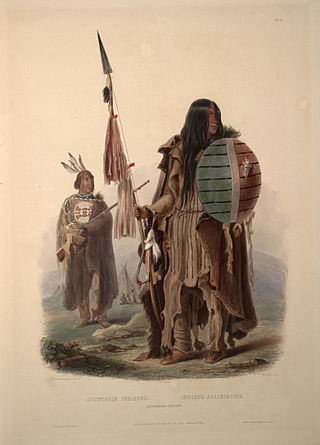Related Research Articles

The Crow, whose autonym is Apsáalooke, also spelled Absaroka, are Native Americans living primarily in southern Montana. Today, the Crow people have a federally recognized tribe, the Crow Tribe of Montana, with an Indian reservation located in the south-central part of the state.

The Piegan are an Algonquian-speaking people from the North American Great Plains. They are the largest of three Blackfoot-speaking groups that make up the Blackfoot Confederacy; the Siksika and Kainai are the others. The Piegan dominated much of the northern Great Plains during the nineteenth century.
The Blackfeet are a tribe of Native Americans who currently live in Montana and Alberta. They lived northwest of the Great Lakes and came to participate in Plains Indian culture.
The Abenaki people are an indigenous peoples of the Americas located in the Northeastern Woodlands region. Their religious beliefs are part of the Midewiwin tradition, with ceremonies led by medicine keepers, called Medeoulin or Mdawinno.
This article is about the spiritual beliefs, histories and practices in Kwakwaka'wakw mythology. The Kwakwaka'wakw are a group of Indigenous nations, numbering about 5,500, who live in the central coast of British Columbia on northern Vancouver Island and the mainland. Kwakwaka'wakw translates into "Kwak'wala-speaking tribes." However, the individual tribes are single autonomous nations and do not view themselves collectively as one group.

The Indigenous peoples of the Americas comprise numerous different cultures. Each has its own mythologies, many of which share certain themes across cultural boundaries. In North American mythologies, common themes include a close relation to nature and animals as well as belief in a Great Spirit that is conceived of in various ways.

The Blackfoot Confederacy, Niitsitapi, or Siksikaitsitapi, is a historic collective name for linguistically related groups that make up the Blackfoot or Blackfeet people: the Siksika ("Blackfoot"), the Kainai or Blood, and two sections of the Peigan or Piikani – the Northern Piikani (Aapátohsipikáni) and the Southern Piikani. Broader definitions include groups such as the Tsúùtínà (Sarcee) and A'aninin who spoke quite different languages but allied with or joined the Blackfoot Confederacy.
Blackfoot music is the music of the Blackfoot people. Singing predominates and was accompanied only by percussion.

The Assiniboine or Assiniboin people, also known as the Hohe and known by the endonym Nakota, are a First Nations/Native American people originally from the Northern Great Plains of North America.

Quillwork is a form of textile embellishment traditionally practiced by Indigenous peoples of North America that employs the quills of porcupines as an aesthetic element. Quills from bird feathers were also occasionally used in quillwork.

Writing-on-Stone Provincial Park is located about 100 kilometres (60 mi) southeast of Lethbridge, Alberta, Canada, or 44 kilometres (30 mi) east of the community of Milk River, and straddles the Milk River itself. It is one of the largest areas of protected prairie in the Alberta park system, and serves as both a nature preserve and protection for many First Nations (indigenous) rock carvings and paintings. The park is sacred to the Blackfoot and many other aboriginal tribes.
The Fifth World in the context of creation myths describes the present world as interpreted by several indigenous groups in the USA and Central America. The central theme of the myth holds that there were four other cycles of creation and destruction that preceded the Fifth World. The creation story is taken largely from the mythological, cosmological, and eschatological beliefs and traditions of earlier Mesoamerican cultures.

Brazilian mythology is the subset of Brazilian folklore with cultural elements of diverse origin found in Brazil, comprising folk tales, traditions, characters and beliefs regarding places, people, and entities. The category was originally restricted to indigenous elements, but has been extended to include:

Darrell Robes Kipp was a Native American educator, documentary filmmaker, and historian. Kipp was an enrolled member of the Blackfeet Nation in Montana and was instrumental in teaching and preserving the Blackfoot language as the director of the Piegan Institute.

Inca mythology is the universe of legends and collective memory of the Inca civilization, which took place in the current territories of Colombia, Ecuador, Peru, Bolivia, Chile and Argentina, incorporating in the first instance, systematically, the territories of the central highlands of Peru to the north.
Vietnamese mythology comprises folklore, national myths, legends, or fairy tales from the Vietnamese people with aspects of folk religion in Vietnam. Vietnamese folklore and oral traditions may have also been influenced by historical contact with neighbouring Tai-speaking populations, other Austroasiatic-speaking peoples, as well as with people from the region now known as Greater China.

Carry the Kettle Nakoda Nation is a Nakota (Assiniboine) First Nation located about 80 km (50 mi) east of Regina, Saskatchewan and 13 km (8.1 mi) south of Sintaluta. The reservation is in Treaty 4 territory.

Napi Rock is located in the Lewis Range, Glacier National Park in the U.S. state of Montana. Napi Rock is a pinnacle on the eastern end of Singleshot Mountain and is easily seen from Saint Mary, Montana. Napi Rock is named for Napioa also known as Nah-pee, a fictional creation myth figure of the Blookfoot who was believed to have created the earth and everything on it.
Aisoyimstan is a god associated with winter and snow in Montana Blackfoot mythology.
References
- 1 2 3 4 5 6 7 8 9 Maclean, John (1893). "Blackfoot mythology". The Journal of American Folklore. 22. 6 (July–Sept): 165–172. doi:10.2307/533004. JSTOR 533004.
- ↑ Grinnell, George (1913). Native American Legends: Blackfoot Legends-Blackfoot Creation. George Bird Grinnell.
- ↑ Wissler, Clark; Duvall, R.C. (1908). "MYTHOLOGY OF THE BLACKFOOT INDIANS". Anthropological Papers of the American Museum of Natural History. 2: 19. hdl:2246/206.
- 1 2 3 Duvall, D.C.; Clark Wissler (1995). Mythology of the Blackfoot Indians. Lincoln, NE: University of Nebraska Press. p. 19.